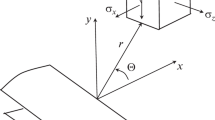Abstract
A fracture criterion for a pre-cracked plate subjected to large deformation is presented in a power-law hardening material based on the energy conservation law. First Hencky equations are applied to a non-linear elastic model in a small strain to derive the criterion and the theory is extended to a large strain case with the aid of numerical analysis. The criterion is expressed as a relation between a crack length and a remote fracture strain, and it is identical with Griffith's criterion when the power exponent is unity.
Large strain and stress fields near a crack tip are also assessed. Experiments with pre-cracked steel plates well verify the theory, that is, the criterion based on elastic analysis appears to apply to an actual plastic material. The transition from the brittle fracture to the present unstable ductile fracture and a physical implication of the reduction of area in tension test are discussed.
Résumé
On présente un critère de rupture pour une tôle préfissurée soumise à une grande déformation dans une matériau durcissant suivant une loi parabolique et en se basant sur une loi de propagation de l'énergie. Les premières équations de Hencky sont appliquées à un modèle élastique non linéaire pour des déformations de faible amplitude en vue de dériver un critère, et la théorie est étendue au cas des grandes déformations à l'aide d'analyse numérique. Le critère est exprimé comme une relation entre la longueur de la fissure et une déformation à la rupture lointaine, et il est identique au critère de Griffith lorsque l'exposant de la loi de durcissement du matériau est l'unité.
Les déformations en amplitude et les champs de contrainte au voisinage de l'extrémité de la fissure sont également prises en considération. Des expériences réalisées avec des tôles d'acier préfissurées vérifient la théorie de manière satisfaisante, c'est-à-dire que le critère basé sur l'analyse élastique apparait applicable à un matériau se comportant de façon plastique. La transition de la rupture fragile à une rupture ductile instable et les implications physiques de la striction lors de l'essai de traction sont discutées.
Similar content being viewed by others
References
A.A. Griffith, Philosophycal Transaction of Royal Society, 221A (1920) 163–198
J.D. Eshelby, Solid State Physics (Edited by F. Seitz and D. Turnabull), Academic Press-New York, (1956)
J.R. Rice,Journal of Applied Mechanics, 35 (1968) 379–386
J.W. Hutchinson,Journal of Mechanical Physics and Solids, 16 (1968) 337–347
G.R. Irwin,Journal of Applied Mechanics, 24 (1957) 361–371
F.A. McClintock,Journal of Applied Mechanics, 35 (1968) 363–371
P.F. Thomason,Journal of the Institute of Metals, 96 (1968) 360–365
A.H. Cottrell, Dislocation and Plastic Flow in Crystals, Oxford at the Clarendon Press, (1953)
W.T. ReadJr., Dislocations in Crystals, McGraw-Hill, New York (1953)
T. Yokobori,Proceedings of the 22nd Japan National Symposium on Strength, Fracture and Fatigue, (1977)
J.W. Hutchinson,International Journal of Solids and Structure, 11 (1975) 575–591
Y. fnYamada, Seisan Kenkyu (Univ. of Tokyo), 19 (1967).
T. Fujita, A. Mizuta and O. Tsuda,Proceedings of the 4th International Conference on Fracture, Waterloo, Canada, Session V-6-a, (1977) Paper 3
M.G. Cockcroft and D.J. Latham,Journal of the Institute of Metals, 96 (1968) 33–39
Author information
Authors and Affiliations
Rights and permissions
About this article
Cite this article
Fujita, T., Mizuta, A. & Tsuda, O. Unstable fracture criterion in a power-law hardening material. Int J Fract 16, 221–232 (1980). https://doi.org/10.1007/BF00013379
Received:
Revised:
Issue Date:
DOI: https://doi.org/10.1007/BF00013379



